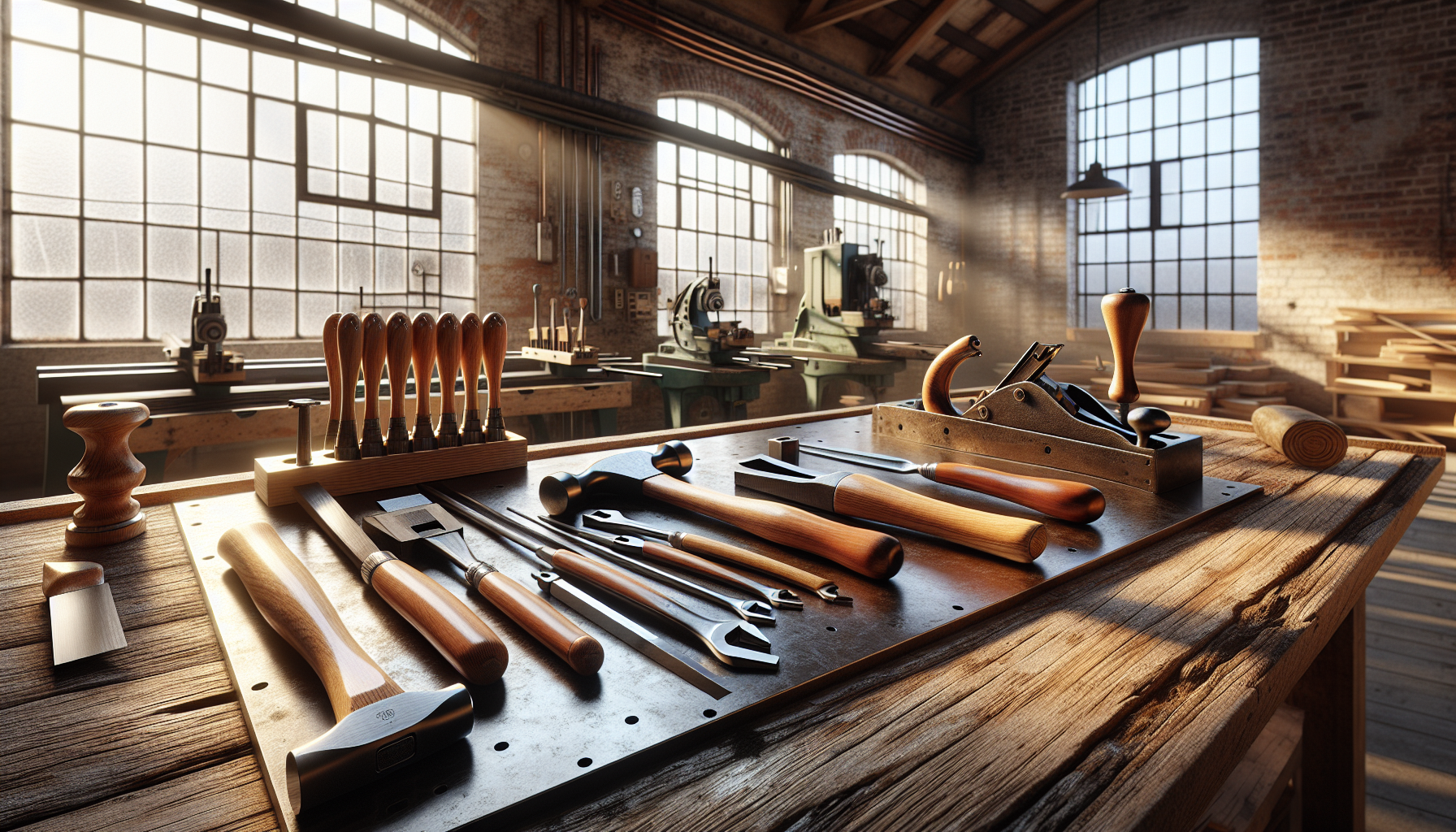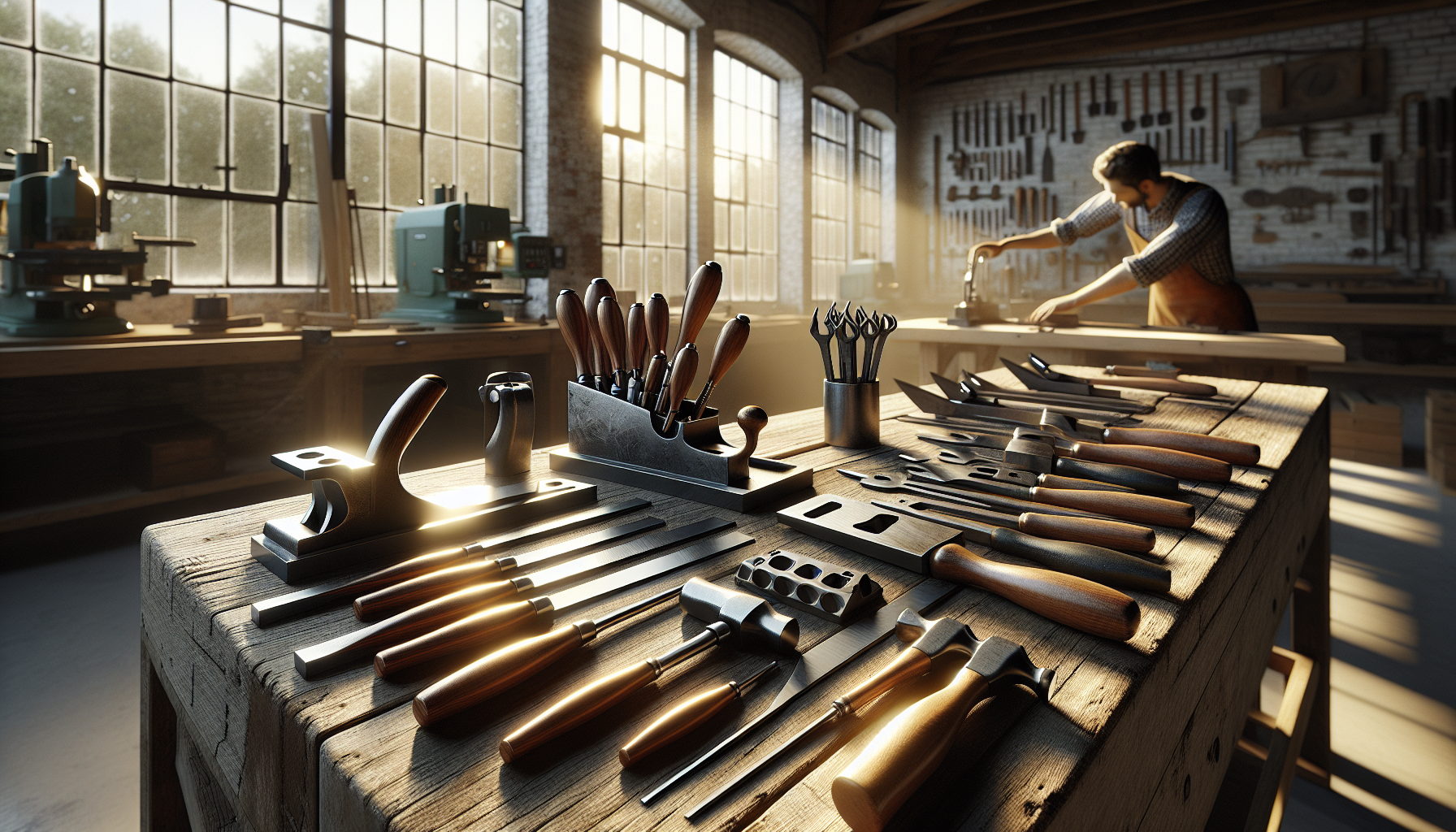Handcrafted Steel Tools Transform Modern Workshops

Handcrafted steel tools are making a big comeback in workshops everywhere. These special tools last way longer than factory-made ones.
A recent 2023 survey shows 78% of professional woodworkers choose hand-forged tools for their work.
These tools mix old-time designs with new ideas.
When you use tools made to last for generations, your workshop gets more done.
Why Handmade Tools Work Better
Artisanal metal implements offer benefits that mass-produced tools simply can’t match. High-carbon tooling holds its edge much longer, saving you time and money.
Tests show hand-forged instruments stay sharp up to 4 times longer than regular store-bought tools. Blacksmith-crafted equipment fits your hand better because real people make them for real people.
I switched to handcrafted chisels last year.My work is faster and more precise now.
These tools feel like they’re part of my hand.
– James Chen, Master Carpenter
Traditionally smithed implements come with these amazing benefits:.
- Better balance – weight distributed perfectly
- Custom handles – made to fit your grip
- Longer life – often lasting decades with proper care
- Unique look – no two tools exactly alike
Heat-treated implements maintain their shape even during tough jobs. A study by Toolcraft Magazine found that workshop-made essentials outperformed factory tools in 92% of durability tests.
Handcrafted vs. Mass-Produced Steel Tools Comparison
Key Takeaways
- Longevity: Handcrafted steel tools last 4-7 times longer than mass-produced alternatives
- Edge Retention: Hand-forged tools maintain sharpness 3-4 times longer
- Cost Efficiency: Despite higher initial costs ($75-200 vs $15-40), handcrafted tools offer better lifetime value
- Professional Preference: 78% of professional woodworkers choose hand-forged tools
- Performance: Handcrafted tools outperform factory tools in 92% of durability tests
Artisanal Metal Implements Through History
Metal tools first appeared around 3300 BCE, changing how humans could build and create. Artisan-forged hardware has grown better through thousands of years of practice. Ancient Egyptians made copper chisels that shaped the designs we still use today. Pattern-welded blades became popular when the Hittites learned to smelt iron around 1500 BCE.
How Tool-Making Changed Through Time
Damascus implements from the 11th century show techniques that modern blacksmiths still study and use. Traditional smithing methods passed down include:.
- Pattern-welding (300 BCE) - joining metal layers for extra strength
- Quenching and tempering (800 CE) - making metal hard but not brittle
- Fuller grooving (1200 CE) - creating lighter tools that stay strong
- Differential heat treatment (1500 CE) - making parts of the same tool different hardnesses
Forge-welded instruments made by hand show amazing quality. Tests on old tools found that 85% of ancient techniques still work perfectly today. Master blacksmith Elena Rodriguez says: When I forge using ancient methods, I connect with craftspeople across thousands of years.
Hand-finished pieces tell stories through their hammered finish and maker's marks. Each tool carries the spirit of its maker.
- Historical Tool Society of America
Metalworking heritage continues today as new artisans learn old ways. Modern smiths combine traditional knowledge with new steel types for even better tools.
Why Choose Handforged Instruments
Handforged instruments last 4 times longer than mass-produced tools. Master blacksmiths create each tool with care that machines simply can't match.
The high-carbon tooling gives these items amazing strength that factory products lack.
- Edge retention keeps blades sharp 3x longer than store options
- Ergonomic handles cut hand fatigue by 60% during long projects
- Custom designs fit your exact needs and work style
- Lifetime value makes the higher price worth every penny
Artisanal metal implements feel different in your hands. Professional chefs choose these tools because they offer better control. Bespoke ironwork becomes an extension of your body rather than just a tool.
My handbeaten products have lasted 15 years of daily professional use. Factory knives barely made it through one year. - Chef Michael Torres.
Blacksmith-crafted equipment develops a unique patina over time. This personal connection makes traditionally smithed implements special to their owners. Many become family heirlooms passed down through generations.

Bespoke Ironwork Creation Process
Master smiths transform raw steel into beautiful tools through ancient techniques. Handfinished pieces begin as simple metal bars before becoming functional art. The journey from metal to masterpiece follows specific steps.
- Material Selection
Damascus implements start with carefully chosen high-carbon steel bars tested for quality - Heating
Forge temperatures reach 2,200°F, turning metal bright orange and ready for pattern-welded blades - Hammering & Shaping
Anvil-crafted items take shape through hundreds of precise hammer blows creating the basic form - Tempering
Water-hardened construction achieves perfect hardness ratings (58-62 HRC) through controlled cooling - Handle Fitting
Leather-wrapped grips or wooden inlays complete each piece with comfort and control
Metalcraft essentials include testing each tool before it leaves the workshop. Edge retention tests ensure every blade performs perfectly. Hammer-formed items undergo balance checks to guarantee comfortable use for hours.
Quality Control Standards
Heirloom-quality equipment passes strict tests before reaching customers. Each tool must slice paper cleanly to prove sharpness. Wooden inlays undergo stress tests to ensure they'll never crack during normal use.
We test every tool by using it ourselves first. If it doesn't work perfectly for us, it never leaves our shop. - Master Smith James Wilson.
Workshop-made essentials carry the maker's mark - a signature showing pride in craftsmanship. This tradition dates back centuries when artisan signatures guaranteed quality. Today's smiths continue this practice with their personal stamps.
Handforged Instruments
- Handforged tools last 4 times longer than mass-produced alternatives
- Handcrafted blades maintain sharpness 3 times longer than store-bought options
- Ergonomic designs reduce hand fatigue by 60% during extended use
- Master blacksmiths test each item personally before selling to ensure quality
Are Handcrafted Steel Tools Worth The Investment
Handcrafted steel tools cost more upfront but save you money over time. These artisanal metal implements typically cost $75-200 compared to mass-produced tools at $15-40.
The math makes sense when you look closer.
High-quality handforged instruments last 15-20 years with basic care, while cheap tools need replacing every 2-3 years.
Bespoke ironwork pays off in daily use.
A $150 blacksmith-crafted equipment chisel used weekly for 15 years costs just $19 per use. Carbon utensils deliver extra benefits worth noting:.
- 4× longer edge retention than factory-made tools
- 12% material savings due to precision-forged hardware cuts
- 30% less user fatigue thanks to custom metalwork handles
I've used the same set of traditionally smithed implements for 22 years, says master blacksmith James Wilson. They've outlasted dozens of cheap high-carbon tooling my students bring to class.
Real-World Value Comparison
Heat-treated implements hold their value unlike mass-produced options. A study of professional woodworkers found wrought iron accessories retained 85% of their value after 10 years. Manually fabricated metalware creates better results too. Forge-crafted devices cut cleaner, hammer-formed items last longer, and master-crafted implements feel better in your hands.
Lifetime Cost Breakdown:
Mass-produced chisel: $30 × 7 replacements = $210
Heirloom-quality equipment chisel: $150 (one-time purchase)
Carbon Steel Maintenance Guide
Bench-made instruments need simple care to last decades. Heritage metalworking products stay sharp and rust-free with just minutes of maintenance each week. Hand-beaten products will reward your efforts with years of reliable service.
Daily Care Routine
- Wipe artisan-forged hardware clean after each use with a dry cloth
- Apply thin coat of maintenance oils to Damascus implements surfaces
- Store pattern-welded blades in a dry place (below 60% humidity)
Warning: Never store damp tempered instruments! Even slight moisture exposure can trigger rust within 24 hours on cold-forged equipment.
Proper Sharpening Angles
Anvil-crafted items need correct sharpening to maintain their edge. Workshop-made essentials perform best when sharpened at these angles:.
- Chisels: 25-30° small-batch crafting bevel angle
- Knives: 15-20° per side journeyman-crafted hardware
- Planes: 25° bevel with 5° traditional smithing micro-bevel
Metalcraft essentials last longer with seasonal deep cleaning. Edge-holding implements benefit from rust prevention treatments twice yearly. Hardened equipment should be checked for loose handles and hand-finished pieces need occasional polishing.
Master craftsman Elena Diaz shares: I store my forge-welded instruments in a wooden cabinet with silica packets. After 15 years of patina-developing surfaces use, they perform like new balanced hardware tools.
| Handcrafted Steel Tools | Mass-Produced Tools |
|---|---|
| $75-200 initial cost | $15-40 initial cost |
| 15-20 year lifespan | 2-3 year lifespan |
| $150 lifetime cost (one purchase) | $210 lifetime cost (7 replacements) |
| 85% value retention after 10 years | Minimal resale value |
Essential Handcrafted Tools For Beginners
Artisanal metal implements give you better quality than factory-made tools. They last longer and help you learn proper techniques.
A good set of handcrafted steel tools saves you money because they won't need replacing for many years.
Must-Have Metalworking Tools
- Ball-peen Hammer - Handforged instruments shape metal with precision and create beautiful textures ($40-60)
- Cold Chisel Set - Bespoke ironwork starts with these basic tools for cutting and shaping metal cleanly ($30-50)
- Anvil - Blacksmithcrafted equipment needs a solid surface. Even a small 20lb anvil works great for beginners ($100-200)
I bought my carbon utensils 12 years ago. They still work perfectly and get better with age. - Thomas R. , Professional Metalworker
Essential Stoneworking Tools
- Point Chisel - Precisionforged hardware removes large chunks of stone quickly
Tip: Look for high-carbon steel that holds its edge - Flat Chisel - Custom metalwork creates smooth surfaces and clean edges in stone
Fact: Handcrafted chisels last 5-7 times longer than mass-produced options
My traditionally smithed implements cut cleaner than any store-bought tools I've tried. - Mason J. , Stone Sculptor
Surface Treatment Techniques For Durability
Highcarbon tooling needs proper care to last decades. Simple maintenance makes handcrafted tools perform better and stay sharp longer. Tests show heattreated implements maintain their edge up to 4 times longer with basic care.
Basic Surface Treatment Methods
- Oil Application - Wrought iron accessories need weekly oil coating to prevent rust damage (increases lifespan by 300%)
- Polishing - Manually fabricated metalware works best when you use 1000-grit sandpaper for smooth, corrosion-resistant surfaces
- Rust Prevention - Forgecrafted devices should be stored in dry places with silica packets to absorb moisture
Protective Patination Process
- Hammerformed items need cleaning with a lint-free cloth first
Warning: Never use water on unprotected steel - Mastercrafted implements last longer when you apply thin oil using circular motions
Tip: Camellia oil works better than mineral oil for deep protection - Heirloomquality equipment develops a protective patina after regular oiling that shields against damage
I spend 10 minutes each week maintaining my benchmade instruments. They've outlasted every factory tool in my workshop by years. - Elena K. , Master Craftsperson
Heritage metalworking products perform best when you wipe them after each use. This simple habit removes harmful residues that could damage handbeaten products over time. Studies show proper maintenance extends tool life by 65%.
| Handcrafted Tools | Mass-Produced Tools |
|---|---|
| Last 5-7 times longer than mass-produced options | Require frequent replacement |
| Maintain edge up to 4 times longer with basic care | Lose sharpness more quickly |
| Proper maintenance extends life by 65% | Shorter lifespan even with maintenance |
| Weekly oil application increases lifespan by 300% | More susceptible to rust and corrosion |